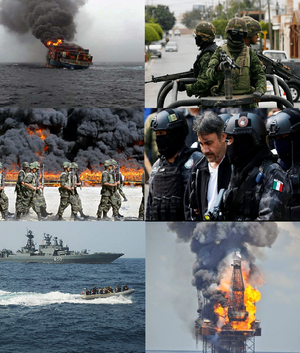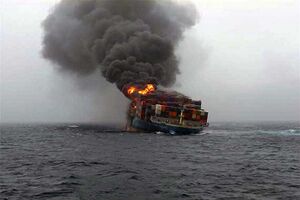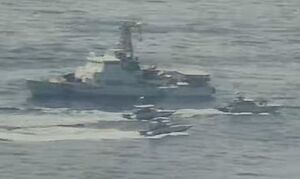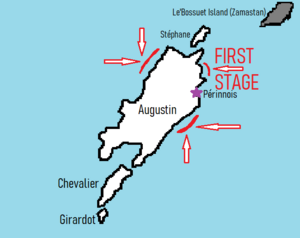2020 Ossinia Conflict
| Ossinia Conflict | |||||||
|---|---|---|---|---|---|---|---|
 Clockwise from top-left: The MV Galen Star lists after being struck by an Ossinian missile; Zamastanian troops in Périnnois; Martin Saint-Yves captured by Zamastanian forces; an oil rig burns after being struck by a missile; an Ossinian Navy speed boat taunts the Z.M.S. Trisiona; New Ossinian Army forces walk in front of a burning drug cache | |||||||
| |||||||
| Belligerents | |||||||
|
|
| ||||||
| Commanders and leaders | |||||||
|
|
| ||||||
| Casualties and losses | |||||||
|
|
| ||||||
|
| |||||||
The 2020 Ossinia Conflict, also referred to as the Ossinia Sea Conflict was a military conflict located mainly in the Ossinia Sea and on the islands of Ossinia. The conflict started when President Martin Saint-Yves of Ossinia ordered the Ossinia Revolutionary Armed Forces to detain or attack vessels of any kind affilliated with the "tyrants of Zamastan and their corporate allies." Exact dates of the start of the conflict are debated, but the general consensus is that April 18th, which marked the detaining of an Avergnonian vessel, the MV Continental. Over the next several weeks, Ossinian naval commanders ordered detentions and missile attacks on international shipping. Incidents included a missile strike on a Janapan oil rig, the harrassing of the Zamastanian navy vessel ZMS Maple Wind, the missile attack on the ZMS August Vendetta, and the sinking of the MV Galen Schulz.
On May 16th, C.C.A. Secretary-General Katherine von Wettin removed Ossinia's seat in the General Assembly. On May 23rd, President of Zamastan Foley Sakzi was granted wider emergency military authority on approving strikes against Ossinian government and military targets. On the morning of May 24th, Zamastan invaded Ossinia, knocking out the majority of its naval capability in one of the largest and most intensive aerial bombardments of the 21st century. On May 27th, Martin Saint-Yves was captured by coalition special forces, and was ultimately extradited to Tregueux, where he and 87 members of his government, military, and state-sponsored piracy program were tried and sentenced in the Tregueux Trials.
Following the toppling of the Saint-Yves regime, a temporary Zamastanian-backed government took power on June 3rd, 2020, and Zamastanian forces entered an occupational phase to stamp out any resisting former-government supporters and keep the peace, reconstruct infrastructure, and deliver relief and aid supplies to the citizens of the island nation. Occupation forces also carried out the task of locating and destroying the many poppy, marijuana, and cocaine production facilities that Saint-Yves' government supported in order to fund his vast criminal alliances. Zamastanian occupational forces left the country on July 31st, 2020, with only a contingent of 400 Zamastanian troops remaining as peace-keeping reinforcements. The conflict was officially declared ended on August 6th by the new interim President Nolan Riveau.
Background
Saint-Yves' rise to power
On the 1st of March 1983, whilst Anouilh was out of the country, the NJM launched a coup which removed Anouilh, suspended the constitution, and established a People's Revolutionary Government (PRG), headed by Plantier who declared himself President. His Marxist–Leninist government established close ties with Yuan, Beleroskov, North Sotoa, and other communist countries. All political parties except for the New Ossinia Movement were banned and no elections were ever held. Jean-Noël Anouilh was granted exile in Zamastan, with President Cassious Castovia cutting off all ties with Plantier's regime.
Plantier died in 1999, with Martin Saint-Yves taking his place. Saint-Yves has been called a dictator by the Zamastanian Intelligence Service, as well as several dozen countries in the C.C.A.. Saint-Yves' regime had been accused of human rights violations such as frequent executions of citizens and political prisoners, torture, and massive censorship. Saint-Yves had long been a critic of international shipping in the Ossinia Sea because despite Ossinia's right under the Coalition of Crown Albatross sanctioned "International Shipping Rights Charter" to set prices for ships traveling through its waters, the Sea is shared regional territory of Ossinia and Zamastan.
In 2012, Saint-Yves demanded the detaining of any shipping vessel that entered the sea through routes that intersected Ossinian waters. While several ships were detained, many were detained in international waters, in some cases causing injuries when Ossinian forces boarded vessels, leading to widespread condemnation. In 2016, a Zamastanian cargo ship was boarded in international waters and was taken back to Périnnois, and a crew member died. President Zacharias Castovia declared Ossinian capture and detaining of ships as piracy, and international shipping began avoiding Ossinia as governments began sanctioning the island nation. This series of events crippled Ossinia's economy.
According to the ZIS, Saint-Yves began hiring mercenaries to train citizens (voluntarily in most cases, but in some cases forcibly) to board and hijack ships in 2014. Saint-Yves reportedly wanted to use state-sponsored piracy to capture ships and then demand ransoms for the vessel and crews to stimulate the crushed economy, effectively turning Ossinia into a haven for modern piracy. In the aftermath of the MV Gideoni Daen hijacking on March 6th, 2019 which left eleven sailors from Austrolis dead, President Anya Bishop called for full sanctions and a pause on international aid to Ossinia, to which 46 nations agreed.
Piracy, missile attacks, and international action

On April 18th, 2020, an Avergnon vessel was hijacked by state-sponsored pirates. The ship was sailed to Ossinia and the hostage sailors were exchanged for Z$60 million. On May 8th, 2020, an Ossinian missile struck a Janapan oil rig, killing 5 workers. Two days later, an Austrolisian shipping vessel was boarded and detained by Ossinian naval vessels, resulting in the death of a sailor. On May 15th, only five days later, dozens of ORNF speed boats harrased the ZMS Maple Wind in Zamastanian territorial waters in a move called "dangerous and provocative" and "increased the risk of miscalculation and collision" by the Zamastanian Naval Forces.[1]
A missile attack occured the next day on the ZMS August Vendetta, killing seven sailors and increasing hostilities even further. The missile is believed to have been intentionally fired from an Ossinian warship, the RNV Gabeaurd, operating in solo manuevers about five miles south of the fleet. While originally thought to be an accidental launch, the Defense Department and the Zamastanian Naval Command said that projections and radio chatter retrieved during and after the incident indicate that the ship intentionally fired the missile, marking the first time an Ossinian military asset attacked a Zamastanian military target. The attack occured in Zamastanian waters, making the attack a move against Zamastanian territory. Admiral Garrett Bittern, a spokesperson for the Navy, said that the Zamastanian Intelligence Service and the Navy were working congruently to determine who in the Ossinian chain of command ordered the attack.
The ZMS August Vendetta was towed back to Anchorhead, Alenchon, where fuel from the ship's damaged section continued to burn for the next two days, making recovery of the killed sailors and any recoverable use from the ship difficult. The seven sailors were buried on May 20th, with President Sakzi saying, "these men and women made the ultimate sacrifice for our country and for our freedom. They will always be heroes. They are with God and in our hearts."
International Response

A Zamastanian container ship, the MV Galen Schulz, was struck by a missile the day following, suffering fatal breaches in the ship's hull that caused it to eventually sink. A Ruskaynian ship, the MV Skipjack, was also detained. President Foley Sakzi called Congressional Hall to an emergency session to convene on how to respond to Ossinia's attacks on May 16th, while Secretary General Katherine von Wettin removed Ossinia's seat in the General Assembly.
In response to both Zamastan's debate and the C.C.A. resolution, Saint-Yves publically blasted the two powers and took personal responsibility for the attacks, declaring that "Zamastan will burn before we are done." Saint-Yves promised "more righteous strikes" on Zamastanian war vessels if they kept "operating in the Ossinia Sea." He also promised more detainings and possible attacks on international vessels, saying "the corporate alliances and alligient governments to Zamastan are not safe if they continue to sail here." On May 21st, a Barangadeshi vessel, the MV Felishan Star, was hit with a missile. The next day, an Avergnonian and a Costa Sarba vessel were detained.
On May 23rd, Sakzi was granted expanded military powers to act against Ossinia. That same day, the Foreign Ministry and the Defense Ministry issued a joint advisory to the international community and the Coalition of Crown Albatross warning to avoid any navigation, international shipping, and aircraft or personal travel around Ossinian territorial waters, the Strait of Cranes, and the South Anchorhead Islands in Alenchon, Zamastan.[2] Speculation quickly spread that President Sakzi was going to order strikes on Ossinia, as activity at both the Zian Presidential Mansion and the Congressional Hall Capitol Building heightened with military personel around 9:30 PM, an unusual time for the executive and legislative function Zamastanian government buildings to be in any sessions. In Drambenburg the sudden announcement prompted the government, which had historically let private companies invest and trade with the Ossinian government, to move towards high military alerts. Ruskayn and Caspiaa put their airforces on high alert, with President Callum MacTavish calling President Sakzi to offer military support.
Zamastanian invades Ossinia
Opening attack

Shortly after midnight at 00:13 AM on May 24th, a surprise military invasion by the Zamastanian Armed Forces against Ossinia began. [3] Neither President Sakzi or Congressional Hall issued a declaration of war, justified by Ossinia's previous attacks on Zamastanian vessels in Zamastanian waters, constituting an act of war. The invasion was led by Zamastanian Army General Avery Reynolds, under the code-name "Operation Black Blizzard".
The invasion was preceded by an intensive series of airstrikes involving eight squadrons of a total of forty two Z-10 Harrier fighter-bombers against military installations on the islands of Stéphane, Augustin, Chevalier, and Girardot. The main island of Augustin was hardest hit, with government and military sites the capital of Périnnois, including the headquarters of the Ossinia Revolutionary Armed Forces, the National Capitol Building, and the Presidential Palace. In addition to the building and facilities sites, the bulk of Ossinia's navy was destroyed or damaged in the initial bombardment, with both of Ossinia's destroyers provided by Drambenburg's Lakhid Myrtan being sunk in their respective ports. It's estimated that at least 400 Ossinians, including soldiers, sailors, officers, and maintenance workers were killed. In the space of three hours, 56 military sites were destroyed, effectively depriving the Ossinian military of any early warning of the coming invasion.
46,000 Zamastanian soldiers participated in landings at three beachheads on the main island of Augustin, codenamed Tyren (on the west coast), Fulcrum (north of Périnnois), and Pelican (south of Périnnois). The first wave of troops landed at 5:32 AM to very little resistance, seizing the beachheads and starting to progress inland to create sectors for troops and supplies to land on the island. General Avery Reynolds described the three objectives of the invasion to reporters following the seizure of the beachfronts;
"We have three objectives in this operation. First, ending the regime of Martin Saint-Yves. Second, to identify, isolate, and eliminate Ossinia's military installations, no matter how big or small. Third, to end sanctions and to immediately deliver humanitarian support to the displaced and to many needy Ossinian citizens."
By 2:00 in the afternoon, Zamastanian forces that had landed on the eastern length of the island reached the outskirts of Périnnois, where resistance started to intensify. Saint-Yves had fled the city towards the interior of the island of Augustin, seemingly unaware that Zamastanian forces had landed at both coasts. Completely surrounded without realizing it, Saint-Yves retreated to a mountain-side compound built by Beleroskov in the 1980s.
Battle for Périnnois

Just over a day into the invasion, the Zamastanian Army's 3rd Infantry Division, with the 2nd Marine Division also present, moved into Périnnois. Units of the Ossinian Special Revolutionary Guard led the defence of the city. The rest of the defenders were a mixture of Revolutionary Guard units, regular army units, paramilitary units, and non-Ossinian volunteers, largely made up of mercenaries. Initial plans were for Coalition units to surround the city and gradually move in, forcing Ossinian armor and ground units to cluster into a central pocket in the city, and then attack with air and artillery forces.
This plan soon became unnecessary, as an initial engagement of armored units south of the city saw most of the Revolutionary Guard's assets destroyed and routes in the southern outskirts of the city occupied. On May 25th, a Special Forces Division executed a raid, later called the "Thunder Drop", to test remaining Ossinian defenses, with 29 tanks and 14 armored fighting vehicles advancing to the Périnnois airport. They met significant resistance, but were successful in reaching the airport, and eventually secured it after heavy fighting.
The next day, another brigade of the 3rd Infantry Division attacked into downtown Périnnois and occupied one of the palaces of Saint-Yves in fierce fighting. Marines also faced heavy shelling from Ossinian artillery as they attempted to cross a creek bridge, but the creek crossing was successful. The Ossinians managed to inflict some casualties on the invading forces near the airport from defensive positions but suffered severe casualties from air bombardment. Within hours of the palace seizure and with television coverage of this spreading through Ossinia, Zamastanian forces ordered Ossinian forces within Périnnois to surrender, or the city would face a full-scale assault. Ossinian government officials had either disappeared or had conceded defeat, and on May 27th, Périnnois was formally occupied by Coalition forces. Much of Périnnois remained unsecured however, and fighting continued within the city and its outskirts well into the period of occupation. Zamastanian forces supported by mortars, artillery, and aircraft continued to attack Ossinian forces still loyal to Saint-Yves and non-Ossinian volunteers. Zamastanian aircraft flying in support were met with Ossinian anti-aircraft fire. On 29th of May, by late afternoon, all fighting had ceased. A total of 41 Zamastanian soldiers and 2,980 Ossinian fighters were killed.
Capture of Saint-Yves
On May 27th, three days into the invasion, Operation Parakeet Race was launched after gaining actionable intelligence identifying two likely locations of Martin Saint-Yves' whereabouts code-named Badger 1 and Badger 2, near the town of Cienfuega. The Forces involved in the operation consisted of approximately 600 soldiers including cavalry, artillery, aviation, engineer and special operations forces.
The forces cleared the two objectives but initially did not find the target. Then, as the operators were finishing and the helicopters called in to extract them, one assaulter kicked a piece of fabricated dry wall, exposing a vaulted room; he prepared to throw a fragmentation grenade into it – in case it led to an insurgent tunnel system, when suddenly Saint-Yves appeared. The operator struck him with the stock of his rifle and disarmed him of a pistol.
Saint-Yves surrendered and offered no real resistance; he was exfiltrated by a Navy helicopter to the main Périnnois Mission Support Site (the government center of the city) where he was properly identified. He had dyed his hair black (a contrast from his typical silver hair), and had passports on his person, leading authorities to believe he was attempting to flee the country, likely to West Chanchajilla and the safety of the Frederick Armbar regime. After proper identification, he was then taken by another Navy helicopter from PMSS and into custody at Périnnois International Airport. Along with a pistol, an assault rifle and Z$2,750,000 in Zamastanian bank notes were recovered from the secret vault.
Two other individuals were also detained, one being a top-tier commander in the Ossinian Revolutionary Armed Forces. There were no casualties in the operation. With the capture of Saint-Yves, it effectively ended his 21-year regime. Zamastanian forces, after his capture, began the process of occupation and peace-keeping operations in Ossinia.
Post-invasion phase
Former-government personel
Zamastanian troops began mopping up resistance in villages across Ossinia after Saint-Yves' capture on the 27th. The islands of Stéphane, Chevalier, and Girardot completely fell to coalition forces as their regional governors and administrators have overwhelmingly thrown their support behind Zamastanian troops when the invasion began, showing the world the clear angered sentiment that much of the country harbored against Saint-Yves. Much of the main island of Augustin had also surrendered by the time of Saint-Yves' capture, with pockets of resistance limited to neighborhoods in the coastal cities.
On May 28th, Sakzi declared the end of major combat operations in Ossinia, due to the defeat of Ossinia's conventional forces, while maintaining that much still needed to be done. Captured military and former-government leaders were held in Périnnois for a period of 2 weeks until the interim government of Ossinia gave control of the prisoners over to Zamastanian forces, and they were taken back to mainland Zamastan for jail sentencing and the preparation for trials and military tribunals. 23 government leaders were tried in Anchorhead, Alenchon, while 89 others, including Martin Saint-Yves were sent to Tregueux, Tregueux. The ensuing Tregueux Trials would determine their criminal charges and their sentences if found guilty. Some individuals faced minimum sentences of five years in prison, while higher up government officials such as Saint-Yves and his most loyal military commanders faced life sentences.
Occupational stage
By June 1st, President Sakzi and the military command ordered 26,000 Zamastanian troops to withdrawl from Ossinia and return to Zamastan, leaving 20,000 to remain as an occupying force tasked with stamping out any resisting former-government supporters, keeping the peace, reconstructing and updating infrastructure, and delivering relief and aid supplies to the citizens of the island nation. Seven checkpoints were created across the four islands of Ossinia, with four of them located on Augustin, two of which were in the capital. A three-week curfew for 9:00 PM was instated, which was two hours more lenient than the 7 PM curfew that had been instated by Saint-Yves since 2004.
New government installed
On June 3rd, a resistance leader named Devin Fougurere, who had been a key ally for Zamastanian forces during the invasion and as an informant for the Z.I.S. in the years prior, was installed as the interim-President of Ossinia. His cabinet was helmed mostly by Zamastanian military advisors, though Fougurere began implementing steps to begin an election cycle for Ossinia's population to develop their own democratically elected government. On July 31st, Ossinians elected Nolan Riveau, one of Fougurere's lawyers who was educated in Rio Palito, to be the new President. Zamastanian forces left the country on the same day, leaving behind a batallion alongside Janapa's CCA peacekeeping force. On August 6th, Riveau declared that the conflict was over and civil authority had been reinstated.
Aftermath
The quick pace of the military operations and the end of state-sponsored piracy in the Ossinia Sea and surrounding waters of the Toyana Ocean was met with praise internationally, despite the controversy brought initially from the worry of civilian casualties. After the war, Ossinia's economy saw massive investments from international governments and aid organizations, which helped boost it from the stagnant sanction-crippled state it was in and began to lift it to a developing economy. With the election of a new government, Nolan Riveau drew praise for his impartiality in forming a democratically elected cabinet. Ossinia's seat in the CCA was reinstated in September of 2020, and in August of 2021 President Atticus Moreau visited the country and spoke during a commemoration of the one year anniversary since the fall of the regime to the nation's youth about the "new way forward."
The war was relatively uncostly, and was widely considered to be the most effective Zamastanian military operation. The overthrow of the Saint-Yves regime showed similarities to multiple revolutions across the world in the following year, namely the 2021 overthrow of Frederick Armbar in West Chanchajilla, the spring revolution in Birat, and the August Revolution in the Slavic Union.



